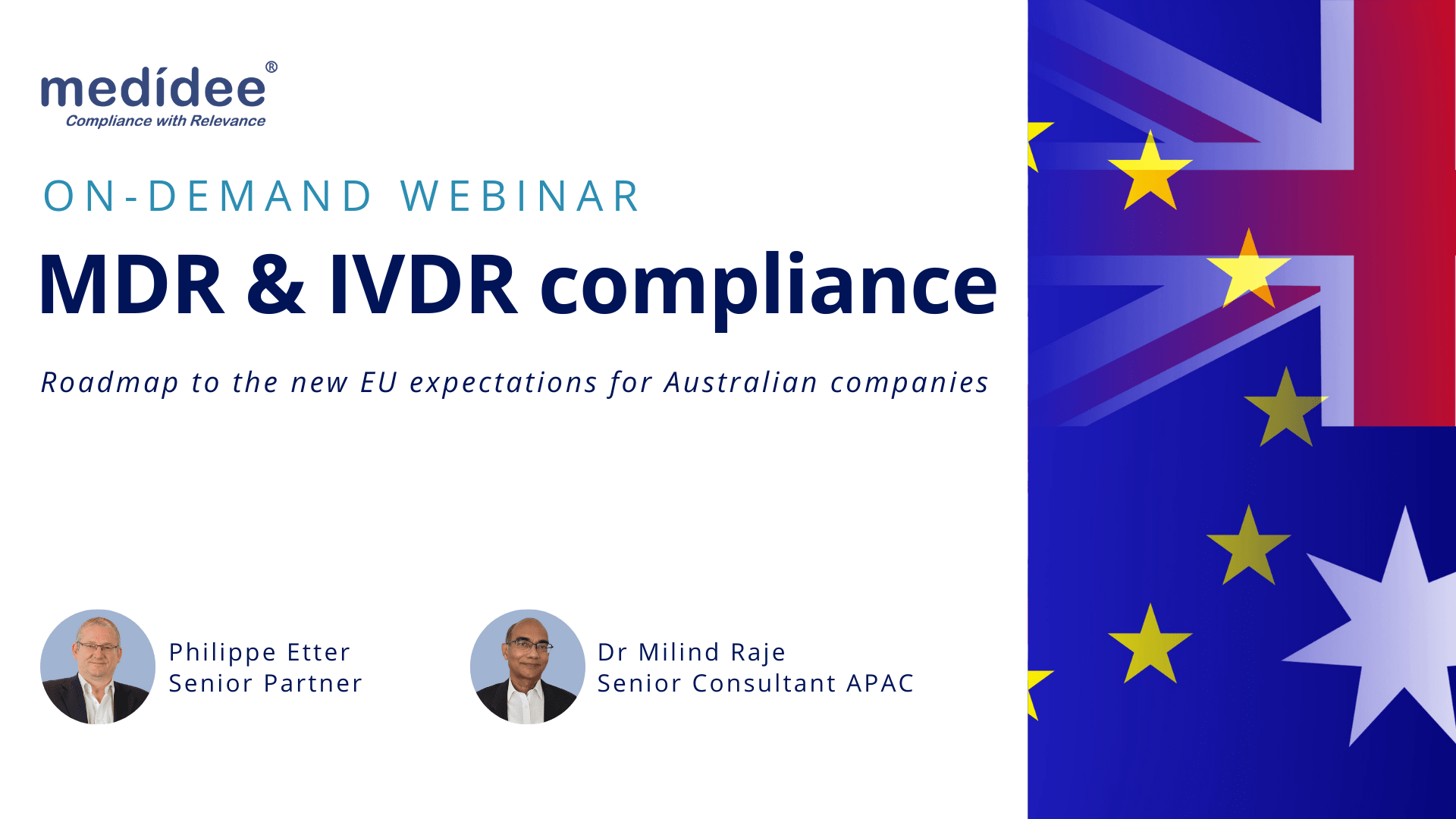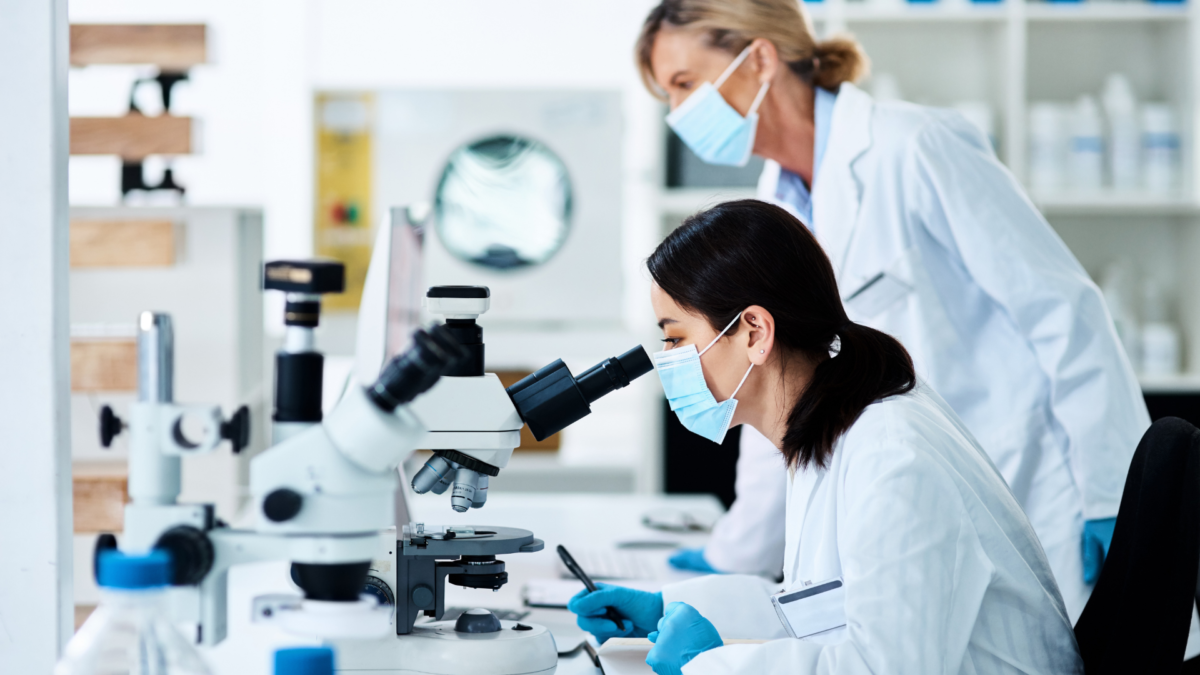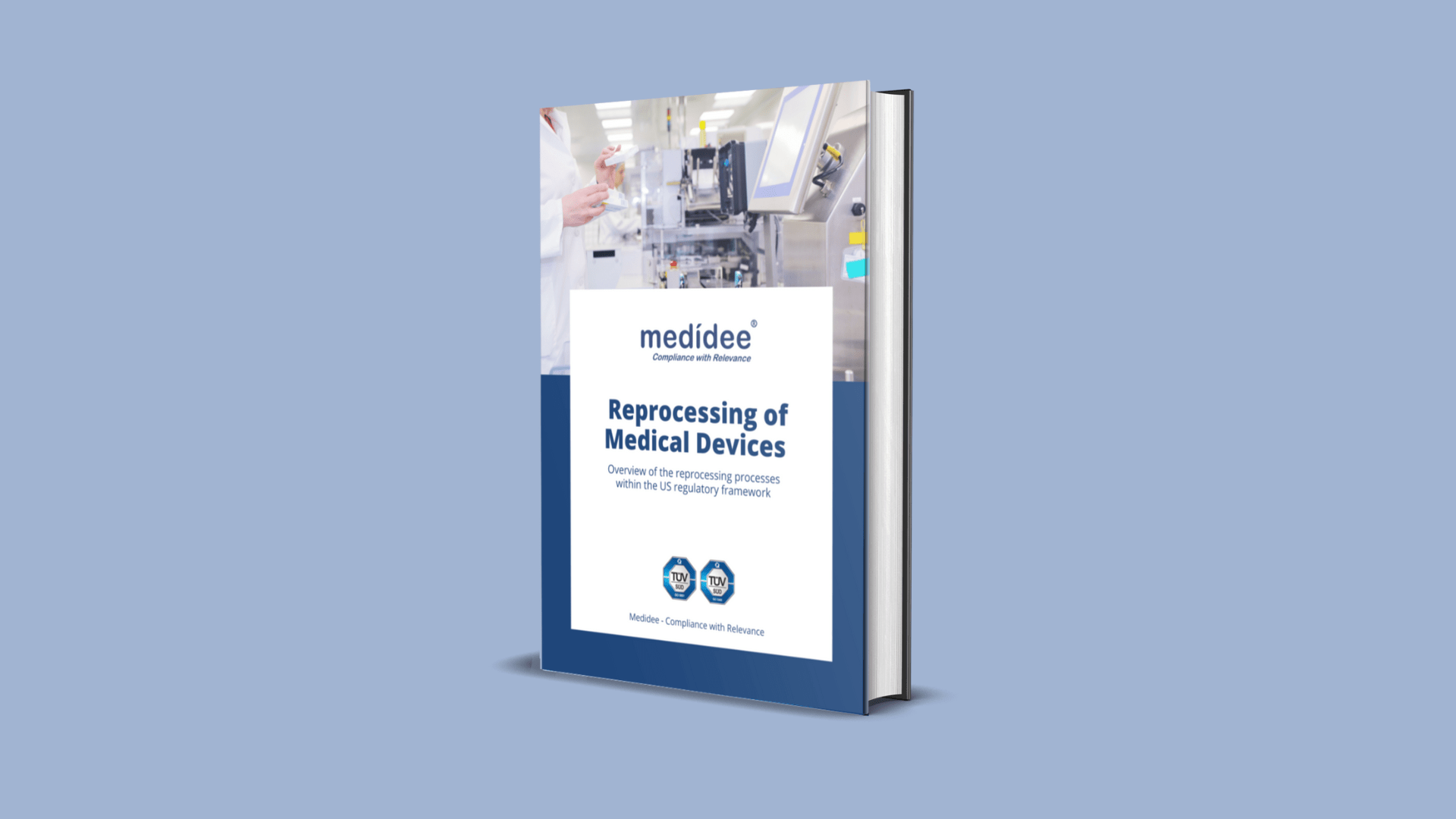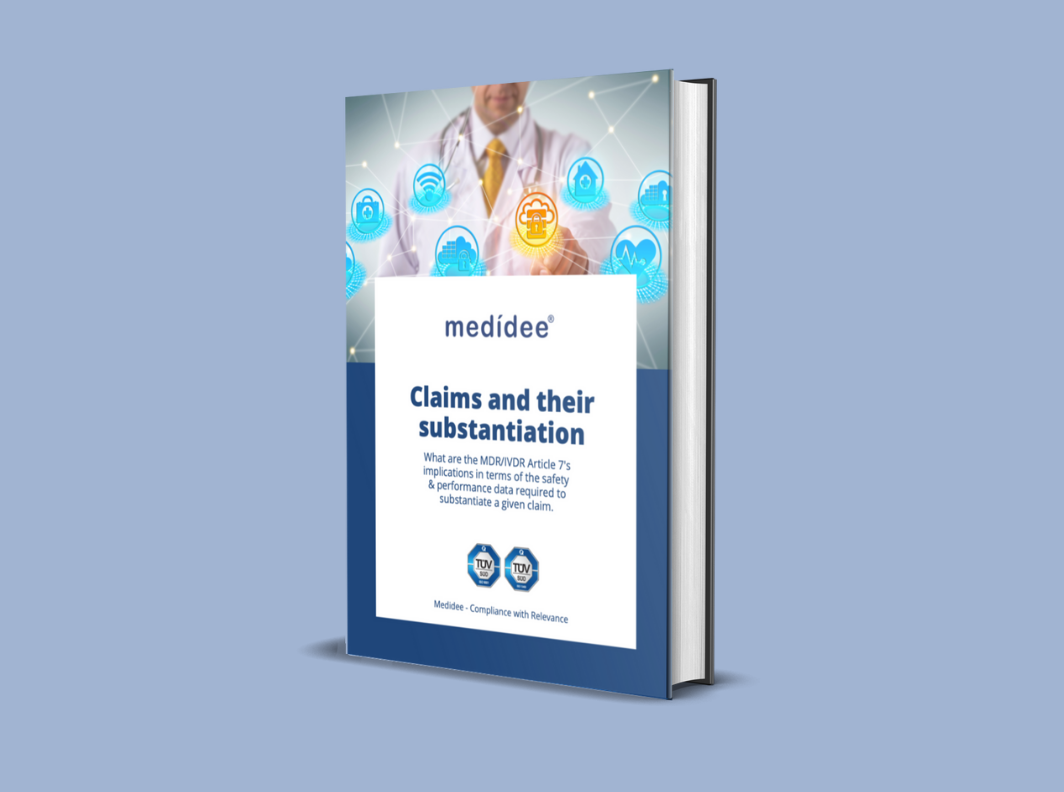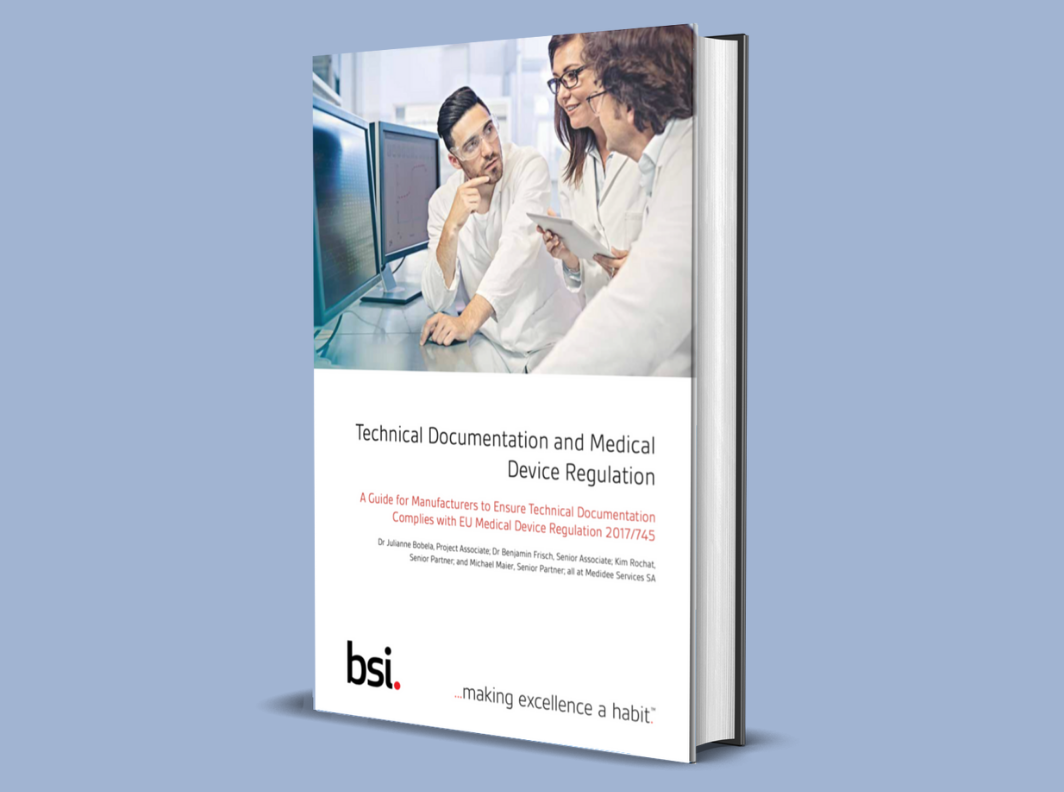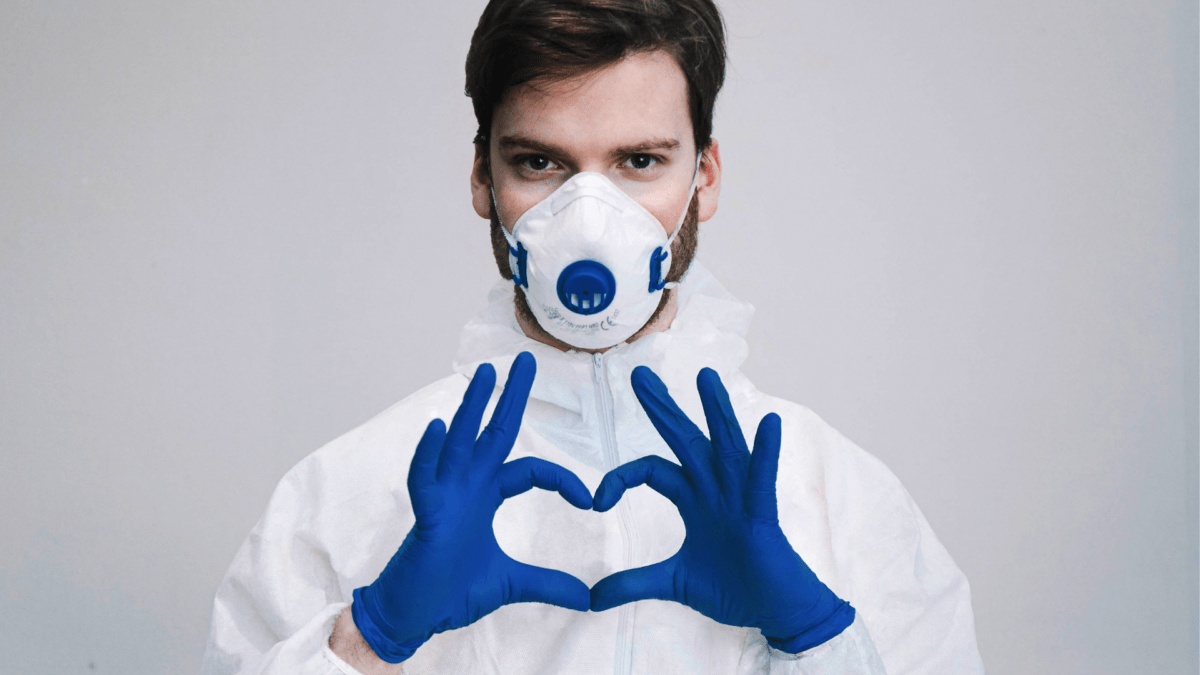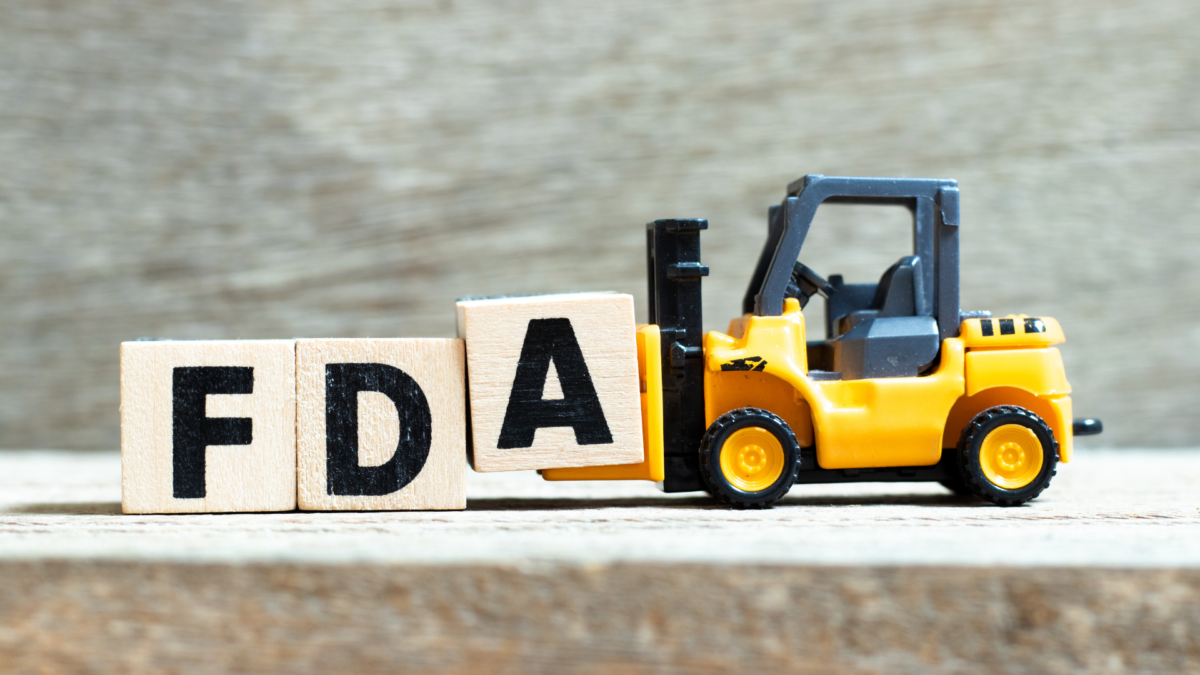[WEBINAR] MDR / IVDR compliance for Australian companies
With the deployment of MDR and IVDR, there is significant pressure on the industry, with short timelines and a clear burden on Notified Bodies.
Australian medical device and IVD companies with established products have limited choice besides upgrading documentation, since the EU remains a dense market with 750 million inhabitants and a large hospital every other 20 miles.
For innovative companies, the question remains complex because the timelines for starting a clinical trial on complex devices remain shorter in the EU, whereas simple devices, such as Digital Health solutions, are clearly easier to develop in the USA.
This webinar covers both sides of these situations:
· What can be done to get existing devices approved under the new EU regulations
· What are tactics for innovative companies
In this on-demand webinar, our experts Philippe Etter and Dr Milind Raje will guide you through the changing trends in EU for medical devices and IVDs:
· MDR current status (including IVDR touch)
· Latest guidances from Notified Bodies
· Planning of conformity assessments for MDR / IVDR transition
· Dealing with Notified Bodies, where to go
· EC-REP, UK-REP, CH-REP
· Clinical tactics in the EU
WATCH THE WEBINAR
Please submit the form to watch:
[WEBINAR] Digital Health, the Regulatory Landscape
Get an overview of the regulatory landscape, hear about the basic concepts and principles, get insights into the necessary steps and anticipate typical pitfalls when bringing a digital health product to the market.
Through these three webinars, you will:
· Get an overview of the regulatory landscape and requirements surrounding digital health applications
· Understand the major principles, concepts and processes
· Learn to sequence the necessary steps and build awareness of possible pitfalls when bringing a digital health product to the market
· Know where and how to find the required information
In this on-demand webinar series, our experts Kim Rochat, Dr Gustavo Hernandez and Dr Stamatia Pagoulatou, will provide you with the basics of regulatory affairs related to digital health.
WATCH THE WEBINARS
Please submit the form to watch:
[WEBINAR] Clinical Investigation & In Vitro Diagnostic Devices
With the implementation of the IVDR, clinical performance studies on In Vitro Diagnostic Medical devices are becoming a central pillar of the device’s clinical evidence.
But what exactly is a clinical performance study?
Which IVD devices require collection of clinical evidence through a clinical performance study?
When is the right moment in a device’s lifecycle for conducting a clinical performance study?
How do I handle clinical data gathered through previous clinical performance study?
Is it mandatory to use the ISO 20916 standard?
In order to avoid delays in the marketing approval process, it is important to understand the full clinical workflow for each type of IVD device. Join us for this on-demand webinar during which our expert Julianne Bobela will guide you through an IVD’s Clinical workflow, including:
· The type of clinical data needed
· The device-specific needs for clinical performance studies
· The characteristics of interventional clinical performance studies
· The regulatory requirements for conducting clinical performance studies
WATCH THE WEBINAR
Please submit the form to watch:
[TECH LETTER] Medical Device Software incorporating Artificial Intelligence: Generating sufficient evidence under the MDR
Artificial Intelligence (AI) and Machine Learning (ML) technologies have the potential to transform medicine by aiding in the detection, diagnosis, and management of diseases. As digitalization of healthcare generates massive amounts of data, medical device manufacturers are increasingly incorporating AI technologies to automate the analysis of such data targeting to create innovative products and improve patient care. This turn towards AI-enabled medical device software (MDSW) is also evidenced by the plethora of studies evaluating the feasibility of artificial intelligence systems across a wide range of health-related indications.
While the interest in medical applications of AI is strong, inconsistent and incomplete collection of evidence remains one of the barriers to the assessment of the safety and performance of AI-MDSW by regulatory bodies.
According to the provisions of Article 61(1) of the MDR EU 2017/745, it is the responsibility of the manufacturer to specify and justify the level of Clinical Evidence necessary to demonstrate conformity of their medical device to the relevant General Safety and Performance Requirements (GSPRs); this level of clinical evidence should be appropriate in view of the device characteristics and intended purpose.
Determining the appropriate level of evidence might be challenging, especially in the case of AI-enabled MDSW which significantly differs from established medical device software in terms of technical and clinical aspects. At the same time, there is no explicit regulatory guidance for conformity assessment of AI technologies, delineating appropriate and practical evidence generation approaches.
Accordingly, this Technical Letter aims to provide an overview of the considerations for evaluating evidence regarding AI-MDSW.
GET THE TECH LETTER
Please submit the form:
[TECH LETTER] Reprocessing of Medical Devices
Reusable medical devices are devices that healthcare professionals can reprocess and reuse on multiple patients. Inadequate reprocessing between patient uses can result in accumulation of chemical and biological debris. Chemical residues can lead to pyrogenicity issues. Biological debris can lead to microbial proliferation even after cleaning, disinfection and / or sterilization processes. Hence, reprocessing is a critical step to guarantee patient safety and, as such, it is covered in the different regulatory frameworks.
This Tech Letter gives an overview of the reprocessing processes within the US regulatory framework and addresses the importance of adequate reprocessing of medical devices, mentioning the letter issued by FDA regarding the change in reprocessing methods for certain urological endoscopes.
GET THE TECH LETTER
Please submit the form:
[TECH LETTER] Claims and their substantiation
This Downloadable Techletter discusses Article 7 of the MDR & IVDR and its implications in terms of the safety and performance data required to substantiate a given claim.
The claims made by a manufacturer regarding the intended use, safety, and performance of their medical device or IVD medical device, both in their form and content, indubitably play an important role toward the commercial success of their product.
It is therefore in the manufacturer’s interest to formulate the most appealing claims possible on the device. This can in certain cases lead to the communication of exaggerated or ambiguous claims on the device, particularly in, but not limited to, promotional material.
It is however imperative for manufacturers to have a clear understanding of what they are allowed or have the obligation to communicate to the user or patient regarding the intended purpose, safety, and performance of their medical devices.
MDR/IVDR Article 7 states in essence that device manufacturers may not communicate any claim on the device which is not adequately supported by objective data. In this context, manufacturers should early in their device development stages define plans and methods in order to capture the safety and performance data necessary to substantiate any claim they intend to make on their devices.
GET THE TECHLETTER
Please submit the form:
[WHITE PAPER] MDR Compliant Technical Documentation
This downloadable white paper co-authored by Medidee and BSI, one of the largest Notified Bodies, gives manufacturers an interpretation of how the changes necessary for the move from compliance with the MDD/AIMDD to the MDR might be implemented, as well as practical hints on what needs to be considered in order to maintain technical documentation as stipulated by the MDR. Although being issued back in 2019, its content remains widely relevant and applicable when it comes to the constitution of MDR-compliant Technical Documentation.
As a Manufacturer, you may have wondered how to ensure your Technical Documentation Complies with EU Medical Device Regulation 2017/745. Indeed, before placing a medical device on the European market, manufacturers need to produce technical documentation providing evidence of conformity with the relevant legislation.
Technical documentation had to comply with the Medical Devices Directive (MDD) 93/42/EEC or the Active Implantable Medical Devices Directive (AIMDD) 90/385/EEC (referred to as ‘MDD/AIMDD’ hereafter).
Since 26 May 2021, manufacturers willing to obtain or renew a CE certificate or to issue a Declaration of Conformity (DoC), are required to have their technical documentation compliant with the Medical Device Regulation (MDR) European Union (EU) Regulation 2017/745 (referred to as ‘MDR’ hereafter).
However, as indicated in Article 120 of the MDR, after 26 May 2021, medical devices can still be placed on the market under the provision of the MDD/AIMDD, providing the certificate was issued prior to this date, that manufacturer continues to comply with either one of the directives and that no significant changes are made in the design and intended purpose of the device.
But Manufacturers of such devices will also have to meet other requirements, which are detailed in Article 120 of the MDR and referenced in this white paper. The certificates issued in accordance with MDD/AIMDD after 25 May 2017 remain valid until reaching their expiry date, but in any case, they become void latest on 27 May 2024.
This necessitates changes for the manufacturers, Competent Authorities (CAs) and Notified Bodies (NBs) on how the technical documentation should be developed and handled.
As mentioned in the first paragraph from Annex II of the MDR, ‘the technical documentation and, if applicable, the summary thereof to be drawn up by the manufacturer shall be presented in a clear, organised, readily searchable and unambiguous manner and shall include in particular the elements listed in this Annex’.
Reading the MDR it becomes evident that the requirements for technical documentation have been raised and will also be subject to more scrutiny by the CA/NB as appropriate.
GET THE WHITEPAPER
Please submit the form:
[ARTICLE] The Regulatory Landscape and the Conformity Assessment Pathways for Masks
Masks have become the mainstay of public health measures adopted during the SARS-CoV-2 pandemic. This article outlines the regulatory landscape and illustrates the nuances that dictate the correct market entry and regulatory strategy for Legal Manufacturers of the various types of masks.
A distinction can be made between three types of masks:
- Community face coverings,
- Surgical/medical masks, and
- Filtering face pieces/respirators
Community face coverings
Community face coverings are sewn from commercially available fabrics and worn in everyday life. In contrast to medical face masks or particle filtering half masks, the EU regulatory framework has not established specific legal provisions for community face coverings. The General Product Safety Directive (GPSD) 2001/95/EC would therefore apply to these masks.
Thus, these are typically not tested in accordance with any relevant legal and normative requirements, and without prejudice to potential specific provisions of EU Member State national legislations regulating these types of face masks, they can therefore be brought to market without any regulatory procedures. In light of the SARS-CoV-2 pandemic, however, these have become a fundamental element of national strategies for containing the spread of the virus, and the European Commission has identified the urgent need for a harmonised and consistent degree of safety in community face coverings.
To respond to this with urgency, CEN has published a workshop agreement on "Community face coverings - Guide to minimum requirements, methods of testing and use", in which considerations relating to design, performance, test methods, packaging, marking and, information for use are noted.
Community face coverings are however not subject to any mandatory conformity assessment by notified bodies or laboratories.
Their design in accordance with accepted best practices and production quality control shall remain the producer's responsibility [1].
Community face coverings that are placed on the market and which meet the requirements laid down in the workshop agreement can be designated as follows: Community face coverings CWA17553:2020 or National specification designation followed by CWA 17553:2020.
Surgical Masks
Surgical masks, also called ‘procedural’ or ‘medical’ masks protect the patient from transmission of infective agents from the wearer and, additionally, in certain circumstances protect the wearer against splashes of potentially contaminated liquids.
These may also be intended to be worn by patients and other persons to reduce the risk of spread of infections, particularly in epidemic or pandemic situations [2]. By virtue of their use “during treatment of human beings”, and “for prevention of disease”, these qualify as Medical Devices.
Before placing these on the European market, Legal Manufacturers are therefore required to ensure compliance with European Medical Device Directive 93/42/EEC as amended by Directive 2007/47/EC (only possible until 26 May 2021) or European Medical Device Regulation (EU) 2017/745.
When worn correctly, such masks cover the nose with the metal band contouring the bridge of the nose, the mask is drawn under the chin and secured in place with ear loops or by tying the tapes firmly around the back of the head. Even though these masks offer high degree of bacterial filtration efficiency, they do not form a tight seal around the nose and the mouth and are understood to function as barriers that offer only limited protection.
Filtering face pieces
Filtering face pieces (FFP), on the other hand, form a tight seal around the nose and mouth [3] and protect the user from being exposed to noxious particles, gases and microorganisms including bacteria, viruses and fungi. By virtue of these masks being “worn for protection against one or more risks”, these qualify as Personal Protective Equipment.
Before placing these on the European market, Legal Manufacturers are therefore required to ensure compliance with European Personal Protective Equipment Regulation (EU) 2016/425.
The intended use and the specific claims advanced by the Legal Manufacturer determine the product category to which a mask will belong, and the subsequent conformity assessment procedures.
-
1/ As medical devices, single use, non-sterile masks usually fall in the lowest risk classification (Class I). For such products, after fulfilling the obligations specified in Art. 10 of (EU) 2017/745:
- the Legal Manufacturer will register the product,
- issue a Declaration of Conformity, and
- affix the CE mark to the product before placing it on the market.
- perform an EU-type examination and a review of the Technical Documentation (Module B),
- followed by either:
- a review of production quality assurance (Module D), or
- internal production control plus supervised product checks at random intervals (Module C2).
- After successful completion of the conformity assessment, the Legal Manufacturer shall affix the CE mark to the product before placing it on the market.
2/ As personal protective equipment, masks intended to protect the wearer from harmful/noxious substances and particles fall in the highest risk categorisation (Category III). For such products, after fulfilling the obligations specified in Art. 8 of (EU) 2016/425, the Legal Manufacturer shall submit an application for conformity assessment to a Notified Body that will :
Table 1 summarises the major differences between these masks and the applicable regulatory requirements.
How Medidee can help
At Medidee, our expertise extends to designing market entry strategies, and review/preparation of Technical Documentation and Quality Management Systems needed by Legal Manufacturers of Surgical/Medical Masks and FFP/Personal Protective Equipment. Contact us now!
This article was written by Dr Mohit Kumar.
References
[1] “Community face coverings - Guide to minimum requirements, methods of testing and use,” CEN-CENELEC Management Centre, Brussels, CWA 17553:2020, 2020.
[2] “Medical face masks – Requirements and test methods,” CEN-CENELEC Management Centre, Brussels, EN 14683:2019+AC:2019, 2019.
[3] “Respiratory protective devices – Filtering half masks to protect against particles – Requirements, testing, marking,” CEN Management Centre, Brussels, EN 149:2001+A1:2009, 2009.
[ARTICLE] IEC 60601 standard series
Medical devices are intended to be used in combination with human beings. Ensuring the safe and effective use of such devices is mandatory according to the European Medical Device Regulation (EU 2017/745) and other legislations regulating medical devices worldwide.
Manufacturers of medical devices are obliged to show compliance to technical state-of-the-art. For instance, the standards of the IEC 60601 series applicable to electrical medical equipment, are listed as consensus standards recognized by the U.S. Food and Drug Administration, and constitute harmonized standards according to Medical Device Directive 93/42/EEC, soon to be also harmonized under MDR. Compliance “can” be demonstrated with the help of the IEC 60601 series of collateral and particular standards for medical electrical equipment. To give more sense to the word “can”, it would be difficult to justify deviation from these standards to a regulatory authority such as a Notified Body, or the FDA.
What are the IEC 60601 standard series?
The IEC 60601 standard series consists of several collateral (horizontal standards like IEC 60601-1-XX which define general requirements for safety and performance) and particular (vertical standards like IEC 60601-2-XX which define product-related requirements) standards and refers to process standards which need to be considered during the different life cycle phases of a medical device. It shall be emphasized that the requirements of applicable particular standards take priority over the general standards, for instance IEC 60601-1.
Medical electrical equipment needs to be evaluated according to IEC 60601-1 general requirements for basic safety and essential performance, IEC 60601-1-2 electromagnetic disturbances – requirements and tests, and IEC 60601-1-6 for usability. Further applicable product standards need to be selected depending on the intended use, intended user and intended use environment of medical electrical equipment.
The IEC 60601-1 standard series is strongly linked to ISO 14971 for application of risk management to medical devices. If the medical electrical equipment uses software, IEC 62304 is applicable as well. IEC 62366-1 for application of usability engineering to medical devices needs to be considered as part of the usability process in combination with IEC 60601-1-6. ISO 14971, IEC 62304 and IEC 62366-1 are so-called process standards to ensure the right process level to guarantee safe and effective medical electrical devices.
Beside the above-listed standards, there is a huge variety on standards for components which will be used within the medical electrical equipment, such as:
And many more…
To meet the general requirements for implementing components in a medical electrical equipment the Conditions of Acceptability (CoA) of such components needs to be considered and verified in the end use of the medical electrical equipment. Considerations for the testing to demonstrate compliance with the IEC series of standards are illustrated through two business cases described below.
Business case 1 - IEC 60601-1 Electrical Safety for a key component of the product
A medical device manufacturer would like to integrate Switch Mode Power Supply (SMPS) in a medical electrical equipment as power supply. Selection of SMPS is important depending on the construction of the Medical Electrical Equipment (MEE). Based on the intended use, intended environment and operational modes of the MEE the following aspects need to be considered for introduction of SMPS:
As a consulting firm, Medidee usually participates at this stage in different ways. On one side, Medidee helps the medical device manufacturer to identify and define the correct specifications, not only in terms of electrical performance, but also in terms of coherence of the options above. Secondly, Medidee assists in making sure that coherence between the different part of the regulatory documentation is maintained along the design and approval process and, also, that possible changes made along the way are handled correctly.
During the certification process with an external ISO/IEC 17025 accredited testing laboratory, relevant tests to verify the applicable requirements will be conducted with the Equipment Under Test (EUT). In this context, Medidee is there to independently support the legal manufacturer of the medical device in the selection and activation of the adequate laboratory.
It is very important to specify requirements in an early development phase to avoid cost intensive design changes during the certification phase of the device. It should be kept in mind that SMPS is part of the insulation diagram and list of critical components of MEE. Furthermore, the electrical and electromagnetic compatibility risk of a MEE needs to be evaluated within the risk management file according to ISO 14971.
Business case 2 - IEC 60601-1-2 EMC testing
A medical device manufacturer would like to initiate certification according to IEC 60601-1-2 to introduce the MEE into the market. First of all, the manufacturer needs to identify which clauses of the standard are applicable for the EUT. Secondly, the medical device manufacturer needs an external ISO/IEC 17025 accredited testing laboratory which has the standard within its scope of testing. According to clause 6.2 Test plan of IEC 60601-1-2, a detailed test plan shall be provided to the test laboratory.
Annex G of IEC 60601-1-2 provides recommendations regarding the minimum test plan contents. However, this information is quite cryptic for non-specialists. This is where Medidee contributes by ensuring the right options and test conditions are selected.
An important aspect for correct EMC testing is the evaluation of operational modes for testing and classification of essential performance. The test requirements can be structured in electromagnetic emission and electromagnetic immunity, as shown below:
Electromagnetic emission – “how does the medical device perturbate the others”:
Electromagnetic immunity: – “how can the medical device be perturbed by the others”
HOW MEDIDEE CAN HELP
Medidee has extensive expertise in the IEC 60601 series and assists manufacturers in identifying the applicable standards and clauses, and in demonstrating compliance with the relevant requirements during different life cycles phases of the medical electrical equipment.
In addition, Medidee supports the communication with external accredited testing laboratories and notified bodies to ensure a smooth certification process of the medical electrical equipment.
[ARTICLE] FDA Breakthrough Devices Program (BDP) and Safer Technologies Program (STeP) for Medical Devices
Launched in 2016, the FDA Breakthrough Devices program (BDP) is intended to provide patients with more rapid access to medical devices that are foreseen to enable a more effective treatment or diagnosis of life-threatening or irreversibly debilitating diseases or conditions.
The new FDA Safer Technology Program (STeP) which is operational since March 2021, aims to accelerate patient access to medical devices that are expected to improve the safety of treatments targeting diseases that are less serious than those qualifying for the existing BDP.
A BDP or STeP designation for a device notably allows companies to benefit from additional FDA input, flexibility with regards to clinical study design and quality system and manufacturing information requirements, and prioritized review during the premarket phase; and can therefore considerably diminish the time necessary for US market approval.
This article will review the principles, features, requirements, application processes, and benefits, of both programs.
The Breakthrough Devices Program (BDP)
The FDA Breakthrough Devices Program (BDP) is a voluntary program intended to ensure patients with timely access to certain medical devices and device-led combination products that provide for more effective treatment or diagnosis of life-threatening or irreversibly debilitating diseases or conditions. It is available for devices and device-led combination products subject to review under a premarket approval notification (PMA), premarket notification (510(k)), or De Novo classification request (“De Novo Request”).
Companies designated for the BDP benefit from additional feedbacks from the FDA during the premarket phase, although the designation does not change the statutory standards for PMA, 510(k) clearance, or De Novo marketing authorization. The Breakthrough Devices Program replaced the previous Expedited Access Pathway (EAP) and Priority Review for medical devices.
The FDA has issued a guidance document on the Breakthrough Devices Program that provides detailed information on the program principle, on the procedure for designation request, and on the program features.
Devices are eligible for breakthrough device designation if both of the following criteria are met:
- The first criterion is that the device provides for more effective treatment or diagnosis of life-threatening or irreversibly debilitating human disease or conditions.
- The second criterion is that the device also meets at least one of the following:
a) Represents breakthrough technology
b) No approved or cleared alternatives exist
c) Offers significant advantages over existing approved or cleared alternatives
d) Device availability is in the best interest of patients
When a device is granted the Breakthrough Device Designation, the manufacturer is ensured direct interactive communication with a sufficient number of well-trained FDA staff, including senior management, with expertise in the application of the BDP.
Interaction with the FDA to obtain feedback on the device development is managed through a variety of options, including “sprint” discussions (i.e. discussions with the goal of reaching mutual agreement on a specific topic within a set time frame (e.g. 45 days)), request for discussion on a Data Development Plan, and request for discussion to reach clinical protocol agreement.
With regards to the last aforementioned point, the FDA will take steps to ensure that the design of clinical trials is as efficient and flexible as practicable. It will, for instance, allow the study design to be adapted during the clinical study and/or approval process.
Moreover, the FDA may allow for part of non-clinical and clinical data to be collected in the post-market phase, provided there are no major safety concerns. In addition, with the BDP designation there is also a prioritized review of regulatory submissions, including Q-Submissions, Investigational Device Exemption (IDE) applications, and marketing submissions.
Finally, for PMA submissions that typically require a preapproval inspection, the FDA intends to expedite the review of manufacturing and quality system compliance for BDP-designated devices.
If the manufacturer can show compliance with the statutory and regulatory requirements by other means than submitting the all the items listed in the FDA guidance “Quality System Information for Certain Premarket Application reviews”, the FDA may accept less quality and manufacturing information. This may occur for instance when the manufacturer has a good track record for quality system compliance and that no new manufacturing issues that could negatively affect product quality or performance are identified. In appropriate cases, the FDA may decide it is acceptable to conduct the inspection of the manufacturing sites after the device has been approved through the BDP.
How to apply for the Breakthrough Devices Program?
To apply for the BDP program, manufacturers shall submit a special Q submission named “Designation Request for Breakthrough Device”. The submission should provide information to describe the device, the indications for use, regulatory history, and it should explain in details the rationale why the device meets the requirements to be eligible for the program. If other requests for FDA feedback are concomitantly pending, manufacturers should consider submitting them after the FDA renders the BDP designation decision as a BDP designation may affect the feedback that FDA provides on the other requests.
The FDA will issue a decision on the BDP designation within a maximum of 60 calendar days, and request any additional information it may require within 30 days. The BDP designation request typically takes the form of an approximately 30 page submission file and usually requires a few weeks for preparation, if necessary with the support of a consulting firm.
Despite a report that the FDA may be open to making public devices having received BDP designations in the future, the decision to do so remains for the moment at the discretion of the manufacturers participating in the program.
It is therefore difficult to obtain reliable data on how frequently BDP designations are solicited and granted. Nonetheless, according to an article published in May 2020 by MedTech Dive who was able to obtain data relating BDP designations from the FDA, there were 11 devices awarded with a BDP designation in 2016, 19 in 2017, and 55 in 2018, 136 in 2019 and 50 and in 2020 as of May.
Thus, the BDP program is increasingly gaining popularity, showing roughly a two-fold increase in BDP designations per year since the launch of the program in 2016. Of these, five BDP-designated devices received full marketing authorization in 2019 (three PMAs, one 510(k), and one De Novo).
No information regarding the number of devices that won final marketing authorizations under the program in 2020 could be retrieved. Nonetheless, this number is expected to increase proportionally to the number of granted designations.
The Safer Technology Program (STeP)
The new Safer Technology Program (STeP) for Medical Devices was designed as a complement to the BDP. The STeP is highly similar to the latter, but tailored for medical devices and device-led combination products that are reasonably expected to significantly improve the safety of treatments targeting an underlying disease or condition less serious than those qualifying for the BDP.
These may include for example devices intended to treat or diagnose non-life-threatening or reversible conditions. As for the BDP, STeP is also available for devices and device-led combination products subject to review under a premarket approval notification (PMA), premarket notification (510(k)), or De Novo classification request (“De Novo Request”). The FDA issued the final guidance on the Safer Technologies Program on January 6th 2021, and anticipated accepting program entrance requests as of March 8th, 2021.
For a device to be eligible for STeP designation, it should meet the following criteria:
- The first criterion is that the device should not be eligible for the Breakthrough Devices Program (BDP) in reason of the less serious nature of the disease or condition treated, diagnosed, or prevented by the device; and
- The second criterion is that the device should be reasonably expected to significantly improve the benefit-risk profile of a treatment of diagnostic by means of substantial safety innovations that provide for at least one of the following:
a) A reduction in the occurrence of a known serious adverse event,
b) A reduction in the occurrence of a known device failure mode,
c) A reduction in the occurrence of a known use-related hazard or use error, or
d) An improvement in the safety of another device or intervention
Similarly to a BDP designation request, manufacturers should apply for a STeP designation by submitting a Q-Submission requesting inclusion in the STeP program. This request should be highlighted in the accompanying cover letter. The request should provide information to describe the device, the expected safety improvement, the indications for use, regulatory history, and justification as to why the device meets the specific STeP eligibility factors.
More information on the contents of a Q-Submission Request for inclusion in STeP may be found in appendix I of the STeP final guidance. Once the program will be operational, the FDA intends to request any additional information it may require on the request for inclusion in STeP within 30 calendar days, and to issue its final decision within 60 days.
Once a device is designated for the Safer Technology Program, the manufacturer can choose to interact with the FDA through the same options as for the BDP, including interactive and timely discussions with FDA staff, senior management engagement, early engagement on Data Development Plans, and sprint discussions. Similarly as within the BDP program, the FDA will also allow for a certain degree of flexibility on clinical trial design and for the collection of non-clinical and clinical data.
In appropriate cases, the FDA also intends to expedite the review of manufacturing and quality system compliance for STeP designated devices by demanding less quality system and manufacturing information, or waiving the requirement for a preapproval inspection of the manufacturing sites.
As the STeP program is not yet operational at the time of writing this article, no data is currently available regarding the number of STeP designations and approvals.
In summary, the FDA Breakthrough Devices and Safety Technology Programs provide considerable advantages that can significantly reduce the time for US market access for devices fulfilling either set of specific inclusion criteria described above. It shall be emphasized that the BDP and STeP programs are complementary and will run in parallel. The BDP addresses devices that provide for more effective treatment or diagnosis of life-threatening or irreversibly debilitating diseases or conditions, whereas the STeP is intended for devices expected to increase the safety of treatments or diagnosis of less serious diseases. Once designated for either of the programs, the manufacturer can expect interactive and timely interaction with the FDA, senior FDA management engagement, priority review, and flexibility with regards to the pre/postmarket balance of data collection, clinical study design, and quality and manufacturing information requirements.
How Medidee can help
Does your medical device potentially meet the criteria for inclusion in the BDP or STeP programs? Our dedicated US market specialists at Medidee are well-experienced with the Breakthrough Devices Program, and may assist you determining whether your product qualifies for inclusion in the BDP or STeP programs, in preparing and submitting your BDP or STeP designation request, and in subsequent interactions with the FDA once the designation is granted. Contact us now!
This article was written by Dr Jérôme Randall.


